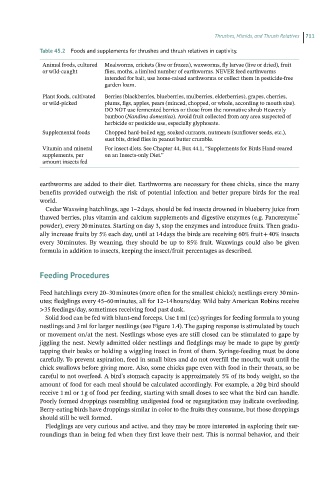Page 709 - Hand rearing birds second
P. 709
Thrushes, Mimids, and Thrush Relatives 711
Table 45.2 Foods and supplements for thrushes and thrush relatives in captivity.
Animal foods, cultured Mealworms, crickets (live or frozen), waxworms, fly larvae (live or dried), fruit
or wild-caught flies, moths, a limited number of earthworms. NEVER feed earthworms
intended for bait, use home-raised earthworms or collect them in pesticide-free
garden loam.
Plant foods, cultivated Berries (blackberries, blueberries, mulberries, elderberries), grapes, cherries,
or wild‐picked plums, figs, apples, pears (minced, chopped, or whole, according to mouth size).
DO NOT use fermented berries or those from the nonnative shrub Heavenly
bamboo (Nandina domestica). Avoid fruit collected from any area suspected of
herbicide or pesticide use, especially glyphosate.
Supplemental foods Chopped hard‐boiled egg, soaked currants, nutmeats (sunflower seeds, etc.),
suet bits, dried flies in peanut butter crumble.
Vitamin and mineral For insect diets. See Chapter 44, Box 44.1, “Supplements for Birds Hand‐reared
supplements, per on an Insects‐only Diet.”
amount insects fed
earthworms are added to their diet. Earthworms are necessary for these chicks, since the many
benefits provided outweigh the risk of potential infection and better prepare birds for the real
world.
Cedar Waxwing hatchlings, age 1–2 days, should be fed insects drowned in blueberry juice from
®
thawed berries, plus vitamin and calcium supplements and digestive enzymes (e.g. Pancrezyme
powder), every 20 minutes. Starting on day 3, stop the enzymes and introduce fruits. Then gradu-
ally increase fruits by 5% each day, until at 14 days the birds are receiving 60% fruit + 40% insects
every 30 minutes. By weaning, they should be up to 85% fruit. Waxwings could also be given
formula in addition to insects, keeping the insect/fruit percentages as described.
Feeding Procedures
Feed hatchlings every 20–30 minutes (more often for the smallest chicks); nestlings every 30 min-
utes; fledglings every 45–60 minutes, all for 12–14 hours/day. Wild baby American Robins receive
>35 feedings/day, sometimes receiving food past dusk.
Solid food can be fed with blunt‐end forceps. Use 1 ml (cc) syringes for feeding formula to young
nestlings and 3 ml for larger nestlings (see Figure 1.4). The gaping response is stimulated by touch
or movement on/at the nest. Nestlings whose eyes are still closed can be stimulated to gape by
jiggling the nest. Newly admitted older nestlings and fledglings may be made to gape by gently
tapping their beaks or holding a wiggling insect in front of them. Syringe‐feeding must be done
carefully. To prevent aspiration, feed in small bites and do not overfill the mouth; wait until the
chick swallows before giving more. Also, some chicks gape even with food in their throats, so be
careful to not overfeed. A bird’s stomach capacity is approximately 5% of its body weight, so the
amount of food for each meal should be calculated accordingly. For example, a 20 g bird should
receive 1 ml or 1 g of food per feeding, starting with small doses to see what the bird can handle.
Poorly formed droppings resembling undigested food or regurgitation may indicate overfeeding.
Berry‐eating birds have droppings similar in color to the fruits they consume, but those droppings
should still be well formed.
Fledglings are very curious and active, and they may be more interested in exploring their sur-
roundings than in being fed when they first leave their nest. This is normal behavior, and their

